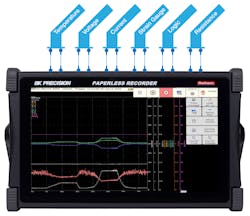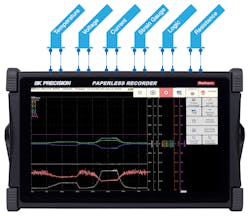The Importance of Data Recorders in Advanced Test
Data recorders have a long history and continue to advance, to keep pace with the applications of today.
Data recording instruments have a history that dates back to the 1800s, when Charles Babbage incorporated a mechanical instrument into a railcar to record over a dozen parameters. Babbage described his prototype as a roll of paper 1,000 feet in length that slowly unraveled itself upon a long table. The model had roughly a dozen pens connected with a bridge crossing the center of the table, each marking an independent curving ink mark. Technology has since advanced to the point where we can record an extensive number of sensors on a small portable instrument.
Older data recorders tended to be limited to only recording signals with values that changed relatively slowly. That was because they had response times limited by the electromechanical pen and paper system used to archive data. Today, such limitations are no longer in place, particularly for the latest generation of recorders. Today’s electronic data recorders feature fast sampling rates, large internal memory, touch displays, and a wide range of input capabilities. Data recorders can replace several instruments and provide additional options such as thermal printing and communication bus analysis.
DMMs, DSOs, and Data Recorders
Digital multimeters (DMM) are used primarily for measuring voltage, resistance and current. Data Recorders, on the other hand, are capable of measuring the same parameters, but can also monitor temperature, humidity, vibration, strain, and rotation, to name a few. Unlike typical DMMs, recorders excel in performing these measurements on multiple channels simultaneously. The data can be analyzed on-screen, with built-in cursors to select specific waveform details, or the data can be transferred to a computer. Recorders also support more complex operations such as writing of custom equations for performing mathematical calculations between two or more channels.
Digital storage oscilloscopes (DSO) have become a widely used means of capturing and storing waveform data and have evolved to include triggering capabilities along with fast sampling intervals. In comparison, data recorders offer more channels, greater vertical resolution, and more memory, which allows recording and comparing of more signals over a longer period of time. When using a DSO, the trigger event might be missed, but a data recorder will capture it because it is recording continually. For example, B&K Precision recorders feature a pre-trigger option to set a percentage of time to capture before the trigger event, ensuring valuable data is not lost.
It is not unusual for data recorders to feature similar triggering mechanisms to those available on scopes, including triggers based on the leading and falling edges of the signal being recorded. Additionally, it is relatively easy to find recorders providing the same kind of analysis available on specialized instrumentation such as powerline quality monitors. Other functionality like X-Y displays, as long found on oscilloscopes, are also available on data recorders
Addressing Applications
Users who need to acquire data for longer periods of time across multiple channels, or from a variety of input signals, will benefit from using a data recorder. These instruments have been designed to enable direct input and measurement of a wide variety of voltage, current, frequency, temperature, strain gauge, and logic signals with voltage inputs ranging from millivolts to kilovolts (Figure 1). This allows a single instrument to simultaneously measure small sensor signals and high voltages in an electrical system, while reducing the challenges configuring several instruments.
A common application for data recorders is in environmental testing where several sensors are required to monitor parameters such as temperature, humidity, wind speed and direction, as well as barometric pressure at a weather station. These environmental tests may also be performed in an environmental chamber to verify how the device under test responds to changes in environmental parameters while monitoring the DUT voltage and current (Figure 2).
Figure 2: Environmental chamber with data acquisition system monitoring the device under test and environmental sensors
Recorders are also widely used in the automotive industry. Motor vehicles contain numerous sensors, electronic controls, and systems which the instrument can monitor simultaneously (Figure 3). Key measurements include voltage and current, force, pressure, stress/strain, speed, and temperature. Many recorders offer the additional capability to monitor and analyze traffic on the CAN or LIN bus, which are widely used interfaces in this industry.
Figure 3: Example of motor vehicle measurements
Data recorders are capable of monitoring systems in industrial settings. Portable recorders aid in preventative maintenance measures which, in turn, help maximize productivity. They can be used to monitor voltage, current, temperature, strain, and vibration signals of industrial equipment, to detect abnormalities and to record data that will allow conveniently scheduled maintenance (Figure 4).
Figure 4: Data acquisition system monitoring typical electric motor parameters
Specifications and features
When considering data recorders, the high-level specifications include the number of input channels, the measurement types (i.e. voltage, current, frequency), the minimum and/or maximum input voltage, the sampling rate, memory size, and the modes of operation. These specifications help determine which instrument(s) will meet individual needs. The number of channels is a trade-off with portability. As the number of channels increases, so does the weight of the unit.
Measurement types and voltage input ranges are fixed numbers that need to be met, but sampling rate and memory size require more consideration. Although a faster sampling rate may seem desirable, it will reduce maximum recording time, given a fixed memory size. For this reason, it is important to have a good understanding of the nature of the signals to be captured when selecting a data recorder.
Many data acquisition systems have multiple modes of operation: One mode for recording over longer periods of time at a lower sampling rate and another mode for recording at a higher sampling rate for a shorter period of time to capture intermittent events. Additionally, some recorders provide the ability to synchronize to an external time base such as IRIG (Inter-range instrumentation group) time codes or GPS signals.
The latest data acquisition recorders and loggers offer features like large touchscreen displays, built-in batteries, and channel counts. For example, the lightweight and portable DAS220-BAT and DAS240-BAT data recorders have built-in batteries for up to 15 hours of continuous recording, where power sources are unavailable, from 10 to 200 channels with a sampling interval of 1 ms, 16-bit vertical resolution and 100 V DC maximum input voltage.
Other examples can be found in the DAS30/50/60 series, which has a sampling interval of 1 µs in memory mode, and up to 9.5 hours of recording time, with an optional thermal printer. An included power analysis application allows for recording and analysis of single- or three-phase power networks. The DAS1700 is a configurable data acquisition system, featuring four types of measurement boards that can be installed in any combination of up to three in the base unit of the recorder or up to six with an optional expansion.
The DAS1700 can stream measurement data directly to the internal solid-state drive at a 1 µs sampling interval and is also capable of recording two files simultaneously. It also includes a power analysis tool along with a function editor. This user interface allows building custom functions to perform mathematical calculations between multiple channels. The result is displayed on a separate virtual channel for easy analysis.
Conclusion
Data recorders have a long history and continue to advance, to keep pace with the applications of today. It is clear that these instruments are essential tools in many industries, and it is important to select the proper data recorder solutions for your applications and industries.

